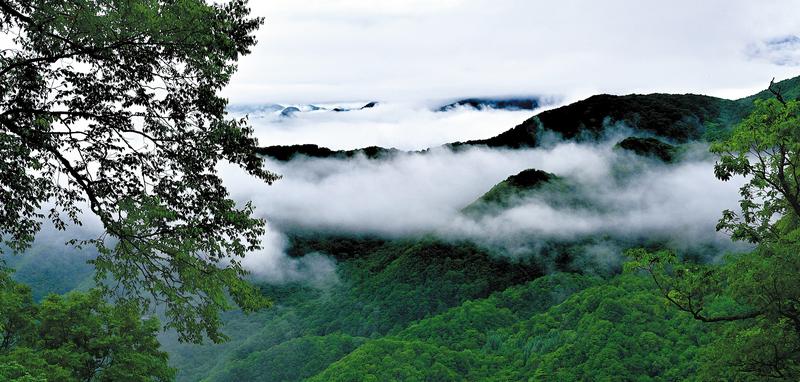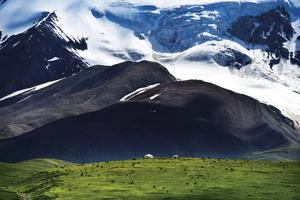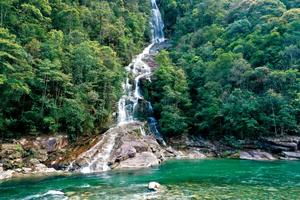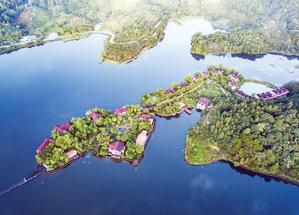 Mountains are wreathed in mist in the Shennongjia National Park, Hubei province. (JIA GUOHUA / FOR CHINA DAILY)
Mountains are wreathed in mist in the Shennongjia National Park, Hubei province. (JIA GUOHUA / FOR CHINA DAILY)
Working as an environmental conservationist in the Three-River-Source National Park on the Qinghai-Tibet Plateau — aka the “roof of the world” — at an average altitude of 4,000 meters is probably one of the most physically demanding jobs on earth.
In addition to excellent health, conservationists must have a range of skills: the ability to ride a motorbike or drive a car; knowledge of cooking in the wild; familiarity with handheld infrared cameras; and fluency in both Mandarin and Tibetan.
Wen Xiao easily meets all those criteria. In 2000, he was one of eight residents of Gangdang, a village in Qumarleb county, Qinghai province, who volunteered to become grassland patrollers.
“We worked for years without payment. At the very beginning, we simply aimed to safeguard the pasture the herdsmen had lived on for generations. Illegal hunting and excessive herb gathering were rampant back then,” the 49-year-old said. Gangdang is famous for caterpillar fungus, which in China is only found on the Qinghai-Tibet Plateau.
In 2016, the Three-River-Source National Park became the first of the country’s 10 pilot national parks after the central government decided to protect its ecosystem. As natives of Gangdang — located in Northwest China and within the park’s boundary — Wen and his team became environmental conservationists a year later.
 Yaks eat grass near a snow-capped mountain in the Three-River-Source National Park, Qinghai province. (PHOTO PROVIDED TO CHINA DAILY)
Yaks eat grass near a snow-capped mountain in the Three-River-Source National Park, Qinghai province. (PHOTO PROVIDED TO CHINA DAILY)
The park, which is home to the sources of three major rivers — the Yangtze, the Yellow and the Lancang — covers 123,100 square kilometers, about 14 times the area of Yellowstone National Park in the United States and 19 times larger than Banff National Park in Canada.
A few months before Wen officially started work as a conservationist, he received training in grassland ecology, the environment and wild animals from experts who had been invited by the local forestry department to provide assistance.
“Thanks to the training, we were aware of the importance of environmental protection — not only the pasture but also the water and wildlife. This is a meaningful mission that will benefit not only our generation but our descendants too,” he said.
“I didn’t get a clear idea of how important our efforts would be until 2016 when an expert who trained us told me that many wild animals and plants were not included in official records in my hometown, but they should be known by more people around the world. From that moment, I knew we would be making history.”
As a result, he decided to keep a patrol diary. In his entries for early May, Wen recorded the appearance of a snow leopard and her cub that he came across near a snow-capped mountain in the park.
 A waterfall flows down a mountain in the Wuyishan National Park, Fujian province. (JIANG KEHONG / XINHUA)
A waterfall flows down a mountain in the Wuyishan National Park, Fujian province. (JIANG KEHONG / XINHUA)
Nature reserves
To collect more information about the endangered high-plateau species, which has a population of 2,000 to 2,500 in China, Wen camped nearby and spent two weeks taking photos of the animals and noting their daily activities.
“The shortest distance between us was less than 200 meters — the mother stared at me for more than 10 seconds. I took it as a warning. I stayed still with my heart beating rapidly, and my breath stopped for a while until she went back to her cub and started to nurse it,” he said.
In 2013, the central government put forward the creation of a national park system with the aim of establishing a series of facilities and building a unified management system by this year.
Two years later, construction was approved for 10 pilot national parks covering more than 220,000 sq km — about 2.2 percent of the country’s territory — to further explore unified management of all facilities. In the parks, the strongest protection occurs within “red line” zones, a key government strategy that places designated areas under mandatory State protection.
A report delivered at the opening of the 19th National Congress of the Communist Party of China in 2017 said a nature reserves system would be developed as part of efforts to build “a beautiful China”.
Last year, the State Council, China’s Cabinet, unveiled a guideline on nature reserves, with national parks as a major component. The reserves are intended to provide systemic protection of natural ecosystems, cultural relics within each region, scenery and biodiversity, and also safeguard the country’s environmental security.
“China’s national parks will be different from those in Western countries because we will prioritize protection of ecosystems rather than the utilization of natural resources,” said Tang Xiaoping, deputy director of the National Parks Management Office at the National Forestry and Grassland Administration.
He noted that in Russia, for example, nature reserves play a protective role, while national parks emphasize the interaction between nature and human beings. In the United States, where national parks have a history of 100-plus years, commercial considerations are a crucial part of the setup.
“The primary purpose of establishing nature reserves is to protect fragile ecosystems, which have been under constant attack from human activities,” he said. “So we will limit human activities in the national parks and minimize their influence on ecosystems.”
 Athletes take part in a marathon in the Qianjiangyuan National Park, Zhejiang province. (YAN SHIJIE / FOR CHINA DAILY)
Athletes take part in a marathon in the Qianjiangyuan National Park, Zhejiang province. (YAN SHIJIE / FOR CHINA DAILY)
Unlike most national parks overseas, which are located in isolated regions, Tang said some of China’s national parks are home to tens of thousands of people.
“Thus, China’s national park management system aims to protect not only ecosystems but also the residents’ traditional lives. Ultimately, protection of nature is aimed at a better future for human beings,” he said.
In the Three-River-Source National Park, for example, some villages have developed a collective grassland ownership system that controls the total livestock and minimizes any negative effect grazing may have on the grassland.
Under the system, former herders are encouraged to become government-paid environmental conservationists or to find jobs in nearby towns and cities to improve their lives after receiving free training provided by the local government.
“Some people may ask why we don’t simply prohibit all human activities in the national parks, especially grazing,” said Tsering Tendru, an official from the park’s branch in Qumarleb county.
“In practice, we’ve noticed that well-planned moderate grazing is good for grassland ecosystems. For example, microorganisms in yak waste can accelerate the decomposition of dried plants and nourish the land for better plant growth in the new season,” he said.
According to the forestry administration, as part of China’s comprehensive strategy of improving the environment and achieving its goal of becoming an “ecological civilization” — a CPC concept designed to promote balanced, sustainable development — construction of the national parks has seen significant achievements in the protection of ecosystems and wildlife.
For example, in the Northeast China Tiger and Leopard National Park, which straddles Jilin and Heilongjiang provinces, the numbers of Siberian tigers and Amur leopards — both designated “critically endangered” in the Red List of the International Union for Conservation of Nature — have risen.
Ten Siberian tiger cubs and seven Amur leopard cubs have been born since the park was listed in 2016, according to Zhang Shanning, deputy head of the park’s management bureau.
 Buildings are surrounded by trees in the Hainan Tropical Forest National Park, Hainan province. (PU XIAOXU / XINHUA)
Buildings are surrounded by trees in the Hainan Tropical Forest National Park, Hainan province. (PU XIAOXU / XINHUA)
Conservation efforts
The construction of the Giant Panda National Park, which covers parts of Sichuan, Shaanxi and Gansu provinces, has provided further protection for a number of endangered species, including the crested ibis, which is also known as “the oriental gem”.
In the 1980s, the IUCN’s red list designated the bird as “critically endangered” because its population numbered just seven.
Widely believed to bring good luck in China, it has witnessed stable population growth, rebounding to 5,000 worldwide after decades of conservation efforts. Construction of the Xi’an-Chengdu High-Speed Railway even took protection of the birds into account.
About 4,400 of the birds now live in the Giant Panda National Park, and their habitat has grown from 5 sq km in the 1980s to 15,000 sq km, according to the park’s management office.
Early this year, the Hainan Rainforest National Park in Hainan province, home to China’s largest rainforest and Hainan gibbons — a “critically endangered” species on the IUCN’s red list — established a research institute.
It issued invitations to top experts worldwide to help protect the rainforest and endangered wildlife.
“We are calling for cooperation with experts worldwide on the management of the park as well as wildlife protection. The world’s top primatologists are especially welcome,” said Xia Fei, director of the park’s management office.
At the Northeast China Tiger and Leopard National Park, which covers 14,600 sq km, a high-tech surveillance system was launched this year to provide real-time protection of the flora and fauna.
The system, which currently covers 5,000 sq km, is supported by infrared cameras, fiber-optic vibration sensors, drones and the Chinese-made Beidou Navigation Satellite System. It provides real-time images of wild animals in the region and also records the activities of forest patrol teams.
At present, the system has 42 base stations and more than 3,000 wireless cameras which are located along 200 kilometers of the Sino-Russian border in addition to other areas of tiger and leopard activity. It is expected to cover the whole park by the end of the year.
Feng Limin, a researcher at Beijing Normal University who has studied China’s tigers and leopards for many years, said the system has collected more than 550,000 videos of a variety of animals within the region.
“The management center collects a large amount of data every day, from wild animals and human activities to changes in the park’s environmental condition,” he said. “It has significantly improved management efficiency.”
According to Tang from the forestry and grassland administration, the system is very expensive, so it has not been used in all the pilot parks.
“However, we hope it can be gradually adopted not only in national parks but also in some nature reserves. It is not only beneficial to wildlife protection, but also to scientific studies for future eco-conservation,” he said.


